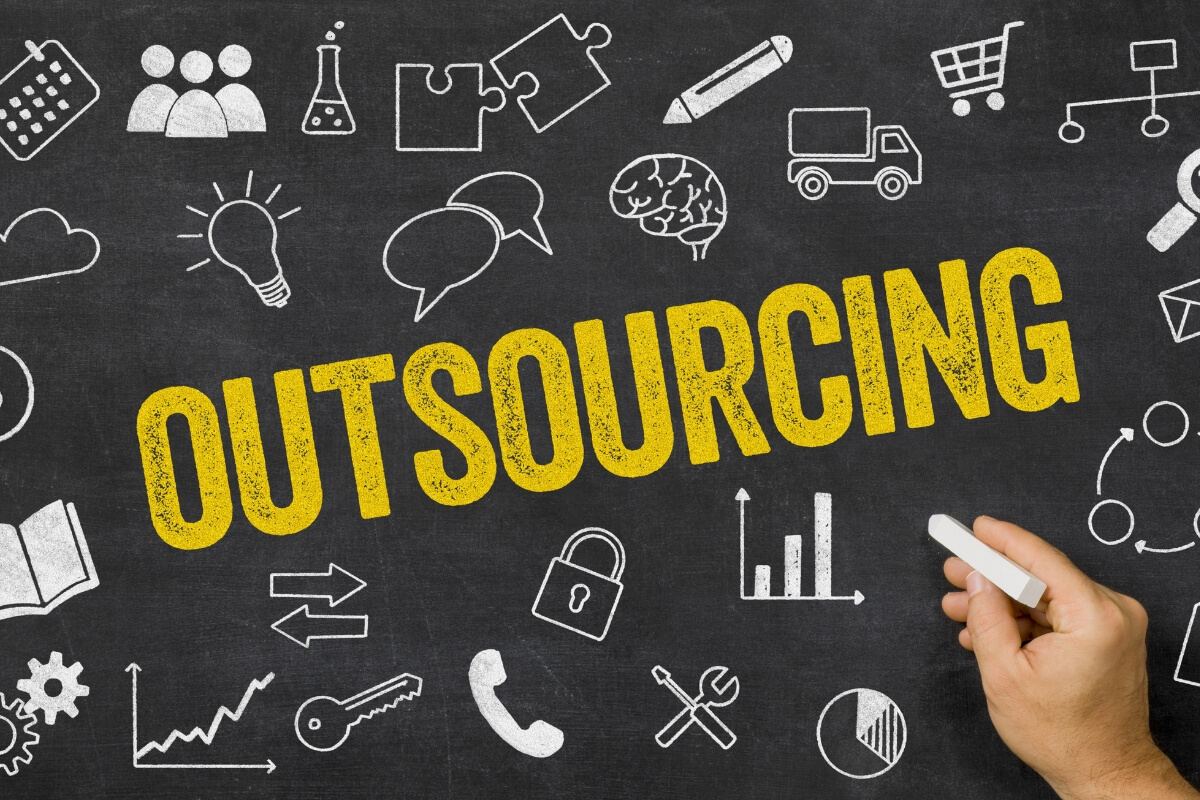Table of Contents
Businesses need a central hub to respond to customer inquiries immediately. Dealing with angry consumers without an appropriate management department might result in chaos.
To address such issues, companies of all sizes hire third-party customer contact centers for streamlined support. Contact center as a service (CCaaS) enables providers to accelerate customer service delivery.
Let’s dive deeper to understand why organizations trust business process outsourcing (BPO) companies to boost customer service. We’ll also tackle which industries commonly hire contact center vendors and how to start looking for one.
Six Reasons Companies Tap Into Third-party Contact Centers

Contact centers are the core of all consumer and business interactions across multiple integrated communication channels. Customers often run to them when encountering issues with their purchases or having questions about product features. They reach out via phone calls, live chat, email, or social media messaging.
With the aid of CCaaS, BPO providers help their clients address customer queries quickly and effectively. The cloud-based contact center software includes integrated communication channels, automation tools, and analytics solutions. Agents use these capabilities to provide customer-first inbound and outbound services efficiently.
According to a new report from Verified Market Research, the global contact and call center outsourcing market was worth $77.78 Billion in 2022. The research firm expects the industry to reach $123.91 billion by 2030. It also predicts that the industry will register a 4.53% compound annual growth rate (CAGR) from 2023 to 2030.
The figures show that many companies rely on third-party contact centers to provide outstanding customer service. The study further reveals that improving performance and generating savings drive the market’s expansion. Below are the top reasons businesses rely on customer contact centers to enhance their consumer support functions.
1. Reduce Operating Costs
Cost-cutting enables small, mid-sized, and large businesses to reduce operating expenses and increase profitability. They implement this process during financial challenges and economic downturns. It also serves as a practical solution when back-office and front-office functions override growth-focused initiatives.
Customer service is a repetitive front-end task requiring considerable funds to hire skilled employees and acquire tech infrastructure. Although this non-core business process doesn’t directly generate revenue, it is vital to establishing a community of loyal customers. But the time-consuming function hinders in-house teams from working on critical projects.
Companies hire third-party contact centers to avoid the high cost of establishing an in-house customer service department. Outsourcing eliminates the need to recruit the best talent, buy advanced systems, or expand office space. The service is available via a long-term contract or as a pay-as-you-need option.
Providers help their clients further reduce their operating costs by deploying subscription-based CCaaS. The cloud-based contact center software doesn’t require expensive hardware to manage multiple communication channels or store massive amounts of data. Agents can easily access all relevant tasks and information through the consolidated online portal.
2. Access Skilled Professionals
Hiring people to fill job openings involves a lot of processes. Businesses need significant funds to streamline the development of promotional recruitment materials and the screening of applicants. They also have to offer generous compensation packages and well-organized training sessions to retain employees.
Customer contact centers ensure their clients can access a pool of skilled professionals at affordable costs. These customer service hubs employ agents trained to handle duplicate tasks efficiently. Their employees are also well-versed in operating CCaaS platforms for accelerated customer response time.
Hence, companies can confidently delegate customer service to that third-party team. This flexible workforce helps scale consumer support operations, especially during peak seasons. Meanwhile, in-house employees have more time to prioritize and work on revenue-generating projects.
3. Deliver Fast and Personalized Customer Service
The shift in consumer behavior since the COVID-19 pandemic has emphasized fast and personalized customer service. According to Zendesk’s latest report, businesses focusing on customer-centricity report profits 60% higher than those that don’t. This highlights the significant impact customer experience (CX) has on consumer spending and brand loyalty.
Contact centers address these expectations through CCaaS, integrating various communication channels for a unified view of customer interactions. Key aspects of this approach include:
- Integration of multiple channels in CCaaS, enabling agents to respond swiftly across platforms.
- Round-the-clock service facilitated by AI and automation, including chatbots and IVR, for efficient problem resolution.
- Prioritization of complex issues by agents enhances productivity and customer satisfaction.
- Provision of self-service options, like FAQs, online forums, knowledge bases, and video tutorials, caters to customers preferring independent problem-solving.
This strategy ensures customer needs are met quickly and effectively, reinforcing loyalty and driving business growth.
4. Integrate with In-house Systems
No matter how reliable BPO companies are, the lack of familiarity with their clients’ products might derail the intended customer service approach. Support agents can smoothly follow scripts when engaging with customers. But they deprive consumers of a personalized experience, resulting in dissatisfaction and disloyalty to the brand.
Customer contact centers address such gaps by providing CCaaS platforms compatible with their clients’ in-house customer relationship management (CRM) systems. Integrating the two solutions helps match customers with agents who can best solve their issues. In turn, agents access relevant data needed to personalize customer engagement.
Given the cloud nature of CCaaS, in-house and third-party teams can have a real-time overview of their task distribution and progress even when working remotely. They can also share files, exchange insights, and connect seamlessly. Such capabilities increase their productivity and help avoid backlogs.
Moreover, CCaaS enables businesses to introduce their products and services to third-party customer support agents. Even if they’re not physically present, agents can still review client offerings at their own pace through the online portal. The videoconferencing feature also allows companies to conduct frequent product training.
5. Conduct Data Reporting and Analytics
Customer service involves massive amounts of personally identifiable information (PII), bank account details, and other sensitive business data. Collecting and analyzing these datasets consumes too much time and effort.
In-house employees might encounter delays in core projects if they also need to handle those tasks. Agents suffer from overwork and burnout without modern solutions to ease their workloads. This negatively affects their work performance and productivity.
As a result, many companies tap into third-party customer contact centers to conduct data analysis and reporting services alongside omnichannel customer support. These hubs optimize AI-powered CCaaS analytics tools to help make sense of big data quickly and accurately.
The resulting insights show how customer needs, demands, and preferences change over time. Such data assists businesses in identifying which aspects require attention and improvement. They can further use that information to develop innovative ways to enhance the customer experience.
6. Improve and Monitor Agent Performance
Support agents play a huge role in delivering excellent customer service. They interact with customers to provide resolutions or information on company products and services. Their ability to communicate and handle complaints well helps satisfy and retain loyal consumers.
Based on a 2022 HubSpot survey, 52% of business leaders said that service agents considered dealing with upset customers their biggest challenge. Slow response times and a lack of personalization are common reasons for frustrated consumers. Insufficient resources to address such issues hinder agents from providing superb customer service.
Customer contact centers help service agents improve their performance by deploying CCaaS. This cloud software features AI and automation solutions that agents can use to provide quick customer responses. The omnichannel system enables them to easily accommodate customer queries across different communication platforms.
Furthermore, CCaaS analytics tools simplify agent performance monitoring and assessment. This capability helps identify whether agents can hit their daily targets or complete routine tasks effectively. Real-time tracking also provides data on factors hindering agents from meeting customer service goals.
The actionable insights guide businesses and providers in advancing agent training and upskilling. They also discover what resources and modern solutions agents need to enhance their work performance. After all, accommodating employee needs encourages them to deliver excellent customer service for continued enterprise expansion.
Who Uses Contact Centers?

As digital modernization and global challenges expand, companies from varied industries constantly explore innovative ways to survive the fast-paced market competition. They must deliver quick and personalized customer service to establish a loyal customer base. This helps them gain a good market reputation.
However, setting up an in-house customer support department demands significant capital. Businesses must spend extra dollars on labor, infrastructure, and space to accommodate in-house customer support. Many companies from the following industries seek contact centers for cost-efficient customer service to save on expenses and ensure returns.
- Ecommerce. Online shopping has become the norm since the pandemic. Because of the surge in online shoppers, ecommerce businesses struggle to manage their in-house operations and customer service simultaneously. Thus, they hire contact centers to provide an unmatched customer experience.
- Retail. Customer contact centers allow retailers to focus on improving their products and daily operations. They also help them promote their offerings by providing telemarketing support.
- Banking and finance. Banks and financial institutions optimize contact center solutions to collect and analyze data on changing customer demands and preferences. Such insights help them personalize financial consulting and support services.
- Healthcare. With fluctuating health emergencies, medical institutions need a dedicated contact center to address healthcare inquiries across multiple communication channels immediately. Integrating CCaaS with electronic health record systems streamlines responses to patient needs.
- IT. Many customers seek technical support to resolve device issues. IT businesses hire contact centers to manage tech support effectively. CCaaS automates responses to simple problems while allowing IT specialists to prioritize complicated tasks.
- Travel and transportation. Travel and transportation industries benefit from enhanced scalability and flexibility when hiring contact centers. The omnichannel approach enables travel agencies to accommodate passenger concerns seamlessly, especially during holidays. Agents are also highly trained to deal with different client types.
How To Begin Outsourcing Customer Service?

Knowing why businesses from various industries collaborate with third-party customer contact centers helps you decide whether to hire one for improved consumer support. The above reasons provide an overview of what to expect from delegating your customer service to a BPO company.
But you need a concrete plan before getting the benefits of customer service outsourcing so that you can balance your operating needs and budget allocations. Follow the tips below to ensure maximum returns from investing in a contact center.
- Define the scope and limitations. Identify customer service needs and challenges you want to resolve with a provider. Lay out the extent and timeline of your contact center requirements. This step will assist your business in achieving measurable objectives and outcomes.
- Look for trusted contact centers. Kick off a proposal call to find the right contact center. You can screen a group of vendors or directly select a single contractor that suits your standards best. Consider referrals and reviews from former or current clients to add weight to your evaluation.
- Create a concrete budget plan. Carefully develop your financial plan. Perform a cost analysis to determine how much savings you’ll generate from hiring a third-party contact center. Make sure this investment won’t affect your overall budget for revenue-generating projects.
- Review the service agreement terms. Host a one-on-one meeting with your selected contact center to finalize contract terms. Combine each other’s business rules, regulations, and resource allocations. Also, tackle billing details and collaboration tools.
- Execute the management strategy. Implement a strategy to oversee your contact center partner after signing an official service agreement. You must remain active in managing the provider to deliver superb customer service consistently.
The Bottom Line
Enterprises of all sizes need third-party contact centers to deliver personalized customer service. These hubs use CCaaS platforms to provide omnichannel support at reduced costs. They also provide critical insights to help companies improve their offerings and empower customer service agents.
Understanding the different reasons businesses trust contact centers to enhance their customer service helps you make a wise investment decision. From setting achievable targets to implementing management strategies, a guide to customer service outsourcing also helps guarantee you pick the best contact center.
Are you aiming to offer an unmatched customer experience without spending more? Start your contact center talks with Unity Communications today. The Inc. 5000 company provides a robust cloud-based CCaaS platform to quickly and effectively meet all your omnichannel needs.



